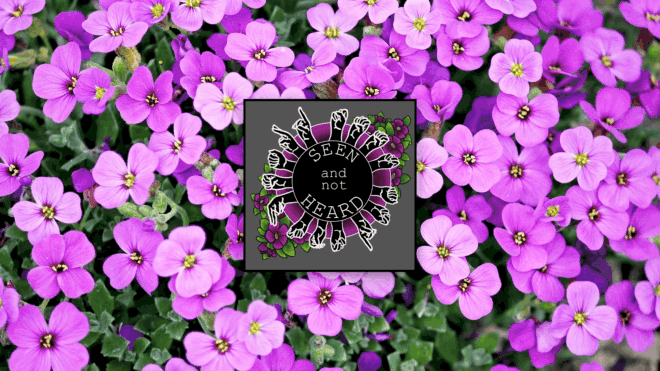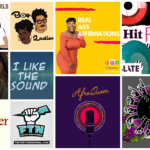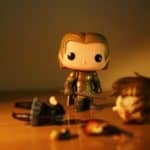Seen and Not Heard: On Hearing, On Listening

Seen and Not Heard is a six-part semi-autobiographical slice-of-life fiction podcast (also known as an audio drama) produced by independent podcaster Caroline Mincks. The series explores the intersection between a disability developed late in life and the emotional abuse and gaslighting that can come along with that kind of experience from the people we love most in the world. It’s an uncompromising portrait of imperfect parents that love us in the only way they understand, even when we tell them bluntly how they could be doing a better job.
This show hit close to home for me in ways that are both obvious and hard to articulate. Ignoring the fact that, for a third of my life, my mother lived with a massive hearing loss, what cut me to my very core was the relationship Seen and Not Heard’s protagonist had with their family: one that was strained and full of willful miscommunication. But the thing that I came out of it understanding was how very human it is to be your own best advocate, even when that doesn’t feel like enough.
Apple Podcasts | Google Podcasts | Stitcher | Website | RSS
Transcripts can be found linked in the show notes of each episode.
Over the course of four micro-prologues, we’re introduced to Bet Kline, a Virginia-based food photographer who came down with an unnamed illness and began to lose their hearing as an adult. We see them go to an ASL (American Sign Language) class for the very first time, intimidated both by their inability to keep up and the gut feeling that the whole endeavor is fraught because none of their loved ones will learn alongside them. We meet their mother, father, sister, and eventual new friend at a busy restaurant where they can barely track the conversation happening around them and are chastised for not wearing their hearing aids, despite their stated discomfort after a long day in them.
Read more: “Everything Is Alive” Defies Genre and Expectations
It’s the early 90’s and my mother, a lifelong Speech-Language Pathologist, begins to lose her hearing. However, unlike Bet and so many others, the specific cause of her loss is apparent: otosclerosis, which is the calcification of your ossicles, one of the three bones that make up your inner ear. Sound is an intrinsic part of my mother’s life and career, so she’ll do anything to maintain her access to it. She’s gotten herself a hearing aid, and though it does a lot to help, her inability to experience the world around her in stereo sends her into a deep depression.
Seen and Not Heard is a show about loudly and proudly advocating for yourself, even when those around you won’t show you the same kind of respect.
Fortunately for her, there’s a surgery that could possibly slow the process of her increased decibel loss, if not outright reverse it. Then again, there is a 1% chance that, instead of slowing it down, her hearing could deteriorate more rapidly. But in 1998, my loving mother takes a chance on her future and goes under the knife for a stapedectomy. Only, instead of removing the calcified bone like he’s supposed to, her first surgeon forces the disarticulated ossicles back together in an attempt to correct the issue manually.
And, afterward, when he asks her to recite the Spondee Words (two-syllable words with equal stress on each syllable, which are employed to obtain thresholds for speech) that have been whispered into her ear, she doesn’t at first realize that she’s memorized them from her own time in college. She’s in a state of twilight anesthesia and relying on her memory and doesn’t immediately recognize that, against all hope, she’s fallen into that 1% of patients who will eventually lose any hearing that she has left in her operated ear.
By the time the series begins in earnest, we’re fully entrenched within the Kline family dynamic. And while, with this being a slice-of-life style drama, there are no direct villains to root against: we do understand quickly why Bet would view learning ASL as a pointless exercise. Their mother, Elaine, is a proud music teacher who seems more offended that her kid is no longer able to engage with her compositions than she is concerned with their health and well-being. Their father, Joe, is an emotionally supportive and loving man who is too busy making excuses for his wife to advocate for Bet. And their sister, Sarah, while on her sibling’s side emotionally, is much more comfortable keeping the peace than pointing out their parents’ hypocrisy alongside them.
There’s an increased focus on the cost of their ASL class and an assertion that by investing time and money in that skill, Bet will somehow allow their culinary skills to atrophy in the process. As if learning a new form of communication that will give them a more accessible life is some kind of fun throwaway hobby. It makes for an isolating experience and fraught dynamic that I think will resonate deeply, especially within millennials raised by closed-off Boomers.
Seen and Not Heard is a show about loudly and proudly advocating for yourself, even when those around you won’t show you the same kind of respect. But it’s also a show that demonstrates how hard that can be, and how sometimes: maintaining a toxic family dynamic is easier than the alternative.

In the early 2000’s I’m an incredibly in the closet baby queer who has spent years experimenting sexually with some of the boys in my life. And one day, in the car on a sunny summer evening as my father drives me the two miles to one of their houses for a sleepover, I’m confronted with my own uncomfortable truth. My step-brother has learned from the neighbor about my proclivities, and now my step-mother is using that fact against my father in her threat of divorce.
My father, who’s already awkward in any conversation that isn’t about technology or tv, stumbles his way through a Seinfeld quote: “Not that there’s anything wrong with that,” he begins, “but you’re too young for that sort of thing. And besides, that’s… just not you.” As if somehow, through his creation of me, he’s also able to make that kind of decision about the way I’m wired.
The pit in my stomach that grows during this confrontation feels endless. I ache to get to the comfort of my friend’s house, and out of the car where I’ll have to talk about it anymore. I deny the truth with every fabric of my being, which brings my father comfort, even if some part of him probably realizes that I’m lying. I pray that that will be the end of that, but the sinister fight or flight mechanism I’d developed years ago during my parents’ divorce rears its ugly head. And I’m plunged into one of the deepest depressions of my life.
I’d be remiss to talk about Seen and Not Heard and not highlight the incredible sound design that crops up in small, but deeply affecting moments across the series. (Full disclosure: Tal Minear, who sound designed the show, is also a writer for DiscoverPods). The series begins in a restaurant with Bet’s family’s dialogue sounding far off and distorted and their inner monologue introduces the situation. They’re kind enough to drop the pretense after a moment, understanding how disorienting the experience must be for the audience, but still gives you the kind of glimpse into what their, and by proxy, creator Mincks’, life is like on a daily basis.
By 2005, after years of bullying for my queer identity, my internalized homophobia and social anxiety have morphed into full-blown suicidal ideation.
But the true standout moment in the entire season comes a few episodes later, as Bet attends a school concert put on by Elaine’s students. It’s hard to explain what exactly they’re experiencing at this moment: as bits and bobs of the children’s voices come in reverberated, mechanical waves lacking both clarity and melody. The experience is incredible, and the scope of aural language these two creators’ developed during this scene is breathtaking.
Mincks initially planned to sound design the series themself but realized quickly that they were in over their head. They understood innately how important it was to get their experience with hearing loss in a way that would translate for a hearing audience, and how they needed a hearing sound designer in order to achieve their vision. You can hear Mincks and Minear discuss the process in-depth in one of the series fantastic interview episodes, available in Seen and Not Heard’s RSS feed.
Mincks and I take the time to speak on Discord about their various attempts to write this story over the last several years. How it existed in various different formats, and how, it isn’t until they’ve found the fiction podcast community that they realized they’d discovered the perfect story to explore their truth. Beyond discussing Bet’s deafness and the overall strained family dynamics portrayed, we stumbled onto another aspect of their real-life identity that made it into the show: OCD.
David, the waiter from the third prologue who eventually becomes Bet’s close friend, is an artist with a strained familial relationship of his own. And we learn that that comes not only from his father’s desire for him to be masculine; to play sports instead of making art, but also because of elements of his mental illness that are beyond his control. Yelling at him for counting his steps or turning the light off an on a certain number of times.
What I love about the way this show tackles OCD, in particular, is that it doesn’t fall into the trap that so many media portrayals have before it: it doesn’t manifest as Adrian Monk’s quirky germaphobia, or Monica Gellar’s Type-A need for things to be organized, but instead as an obsessive, needling thought that can send you into an intense anxiety spiral and ruin your whole day, if not longer.
The OCD that David experiences Seen and Not Heard is not cute, in the way that we’re so used to seeing. It is a serious mental illness that is treated as such. When asked if Mincks originally intended to create a single character with both aspects of their real life, they admit that, while that was initially the case, it became too hard to balance those aspects in a single character. Deciding to have David experience a disability of his own, separate from Bet’s deafness, opened up a lot of story opportunities. Allowing each character to understand and support the other, if not fully, then at least better than either of their own families will ever try to.
Read more: How to make your podcast more accessible using transcripts
By 2005, after years of bullying for my queer identity, my internalized homophobia and social anxiety have morphed into full-blown suicidal ideation. My mother fiercely advocates for my need to get help: first through talk therapy, and then eventually, through a low dose of anti-depressants. My father, ever the Boomer he is, is furious. He doesn’t understand what I could possibly have to be depressed about when my every need is taken care of and I have every instrument, or video game, or CD I could possibly want for. Angry that I could feel that any decisions they’ve made for my life could’ve been done in error and that I’d talk to anyone outside of the family about private matters.
He and my stepmother sit me down in the den of our home to talk to me about the dangers of medication. How they’ll make me put on unnecessary weight as if a few extra pounds are more detrimental to my well-being than the desire to no longer exist. It is a battle, but one that my mother and I ultimately persevere through, as my needs are taken care of and I receive access to the care I need to survive despite them.
There is something about our parents’ generation that finds strength in bottling everything up. Like somehow, if we keep everything in the furthest reaches of our psyches and just put on a good face for the world, we’ll be healthy and well-adjusted people. And, in excavating those deeply traumatic parts of ourselves, we’re dredging up thoughts and feelings too painful to have again. As if holding onto them and never discussing it means we’ve healed.
We watch this play out in real-time as Seen and Not Heard progresses. Bet’s grandmother’s health has been in decline for a while, but when she falls ill and the family needs to visit her on her deathbed, they’re given the chance to confront their mother for her failings. Joe and Sarah are inconsolable at their impending loss, whereas Elaine is in control mode: making the calls necessary to mitigate the situation on a practical level, if not being there for her family emotionally. Bet points out Elaine’s inability to be there for them during their own time in the hospital which they haven’t forgiven her for and says that she has the opportunity to make amends by being there for her husband and daughter now. Here, we’re given the most in-depth look at Elaine’s trauma yet and learn a story about her own childhood witnessing her mother’s death at a young age, which helps a lot of her failings during Bet’s illness click into place.
It’s 2013 and my mother has found another surgeon willing to try giving her another stapedectomy. At this point, she has lived for 15 years deaf in one ear, with a variety of hearing aids and a purse full of loose batteries, and her optimism for the procedure isn’t high. Chances are nothing about her life will change, and she’s okay with that fact, but her new surgeon’s willingness gives her hope.
When asked if Mincks originally intended to create a single character with both aspects of their real life, they admit that, while that was initially the case, it became too hard to balance those aspects in a single character.
I’m living in Brooklyn in my first year after college making no money and in the market for a new pair of Doc Marten’s. It’s two weeks after my mom’s surgery, which seems to have been a success, despite the fluid buildup that’s prevented her from knowing for certain how much of her hearing has gotten back. I’m torn between a cheap pair on sale I don’t like as much, and a more expensive pair with a lifetime warranty.
For the first time in almost two decades, my mom, without telling me, tries to put the phone up to her previously deaf ear. And as I ramble to her about the pros and cons of my decision, I can hear happy tears in her voice. The surgery has done its job. Her hearing is back. And to celebrate that fact, she tells me to buy the better pair of boots.
Seen and Not Heard is a series that does many things very, very well. It depicts a variety of incredibly human emotions and experiences in a visceral way. It illustrates multiple disabilities with a deftness I’d yet to see in any medium done as artfully or true to life. Mincks gives us a story of forgiveness and support and familial love and failings that remind us what it’s like to truly be human. And it does all of this without the sci-fi or fantasy trappings that so many other shows in the medium use to explore the world in a way that is one step removed. It is a masterclass in storytelling, performance, and sound design, and I genuinely hope that you will give it a chance.













2 Comments
Pingback The 10 Best Podcasts By Autistic Creators To Listen To This Autism Awareness Month | Discover the Best Podcasts | Discover Pods
Pingback "How To Love Your Body" Helped Me With My Eating Disorder | Discover the Best Podcasts | Discover Pods
Comments are closed.